牛津初中英语7A Unit 5 Grammar 现在进行时教学设计2007
- 格式:doc
- 大小:43.50 KB
- 文档页数:9
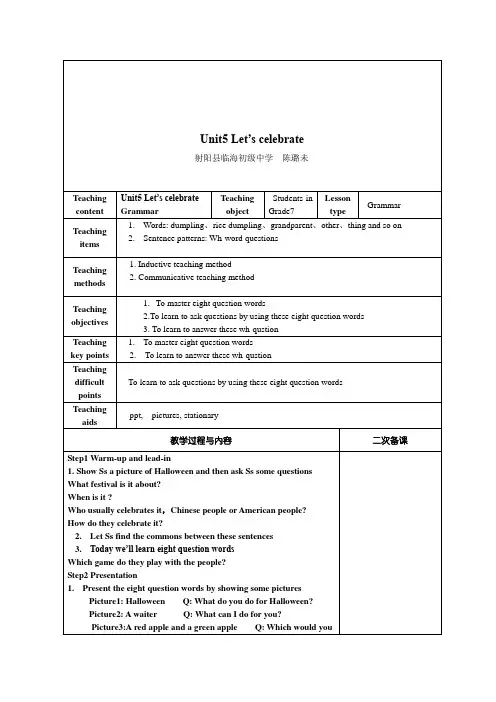
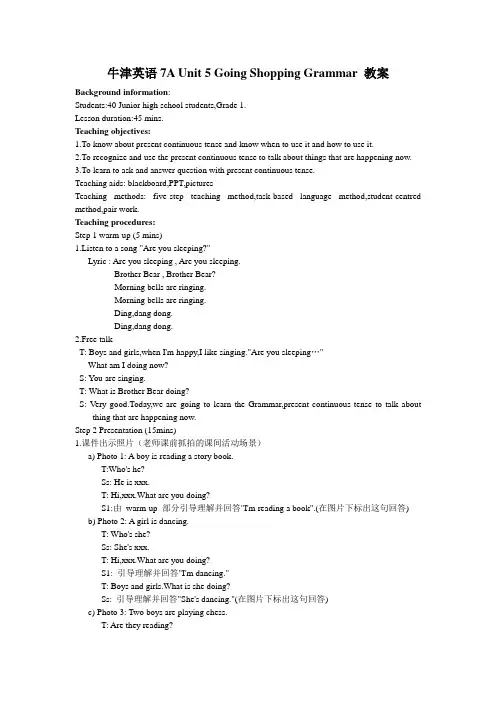
牛津英语7A Unit 5 Going Shopping Grammar 教案Background information:Students:40 Junior high school students,Grade 1.Lesson duration:45 mins.Teaching objectives:1.To know about present continuous tense and know when to use it and how to use it.2.To recognize and use the present continuous tense to talk about things that are happening now.3.To learn to ask and answer question with present continuous tense.Teaching aids: blackboard,PPT,picturesTeaching methods: five-step teaching method,task-based language method,student-centred method,pair work.Teaching procedures:Step 1 warm-up (5 mins)1.Listen to a song "Are you sleeping?"Lyric : Are you sleeping , Are you sleeping.Brother Bear , Brother Bear?Morning bells are ringing.Morning bells are ringing.Ding,dang dong.Ding,dang dong.2.Free talkT: Boys and girls,when I'm happy,I like singing."Are you sleeping…"What am I doing now?S: You are singing.T: What is Brother Bear doing?S: Very good.Today,we are going to learn the Grammar,present continuous tense to talk about thing that are happening now.Step 2 Presentation (15mins)1.课件出示照片(老师课前抓拍的课间活动场景)a) Photo 1: A boy is reading a story book.T:Who's he?Ss: He is xxx.T: Hi,xxx.What are you doing?S1:由warm-up 部分引导理解并回答"I'm reading a book".(在图片下标出这句回答)b) Photo 2: A girl is dancing.T: Who's she?Ss: She's xxx.T: Hi,xxx.What are you doing?S1: 引导理解并回答"I'm dancing."T: Boys and girls.What is she doing?Ss: 引导理解并回答"She's dancing."(在图片下标出这句回答)c) Photo 3: Two boys are playing chess.T: Are they reading?Ss: No,they are not.T: What are they doing?Ss: They're playing chess.(在图片下标出这句回答)d) 老师领读图片下的句子2.观看体育课录音,老师适时暂停并问"What are they doing?"引导学生回答They are walking.They are jumping.They are sitting.They are running. 在课件上标出动词,发现running,sitting双写.3.Get the Ss to play a guessing game.Using: (1)-What's he doing?-He is …ing.(2)-Is he …ing?-Yes,he is./No,he isn't.T: Work with your partner and make a dialogue like this.(用开火车的方式请第4组同学进行对话)T: Then,let's learn the structure of the present continuous tense.课件1I am Looking forsome food.You/We/They areHe/She/It isI am not sleeping.You/We/They are notHe/She/It is notRules: 1.be + v.ing 表示动作或现阶段正在进行或发生2.标志性词:now.listen,look,right now,at present,at the moment(此刻)3.肯:S(主语)+ be +v.ing否:S (主语) + be + not + v.ing课件2Am i eating.Are you/we/theyIs he/she/itYes, I am. No, I am not/amnot.You/We/They are. You/We/They are not/aren't.He/She/It is. He/She/It is not/isn't.Rules: 疑问句:Be + S (主语) + v.ing肯:Yes,S (主语) + Be.否:No, S (主语) + Be + not.。
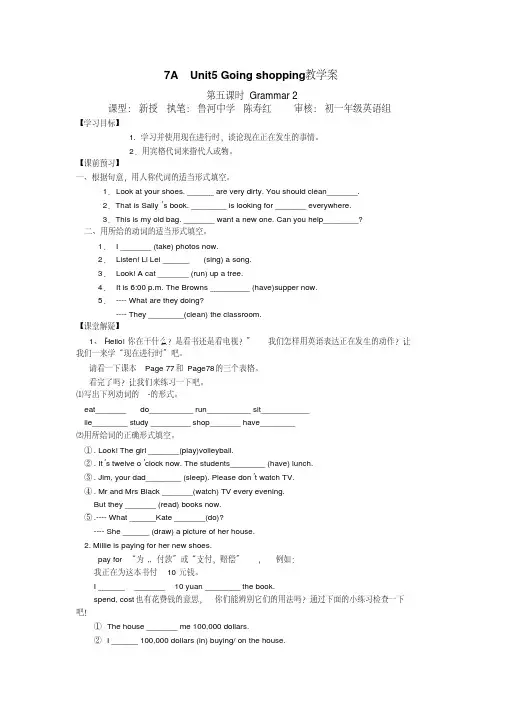
7A Unit5 Going shopping教学案第五课时 Grammar 2课型:新授执笔:鲁河中学陈寿红审核:初一年级英语组【学习目标】1. 学习并使用现在进行时,谈论现在正在发生的事情。
2.用宾格代词来指代人或物。
【课前预习】一、根据句意,用人称代词的适当形式填空。
1.Look at your shoes. ______ are very dirty. You should clean_______.2.That is Sally’s book. ________ is looking for _______ everywhere.3.This is my old bag. _______ want a new one. Can you help________?二、用所给的动词的适当形式填空。
1.I _______ (take) photos now.2.Listen! Li Lei ______(sing) a song.3.Look! A cat _______ (run) up a tree.4.It is 6:00 p.m. The Browns _________ (have)supper now.5.---- What are they doing?---- They ________(clean) the classroom.【课堂解疑】1、“Hello!你在干什么?是看书还是看电视?”我们怎样用英语表达正在发生的动作?让我们一来学“现在进行时”吧。
请看一下课本Page 77和Page78的三个表格。
看完了吗?让我们来练习一下吧。
⑴写出下列动词的-的形式。
eat_______ do__________ run__________ sit___________lie________ study _________ shop_______ have________⑵用所给词的正确形式填空。
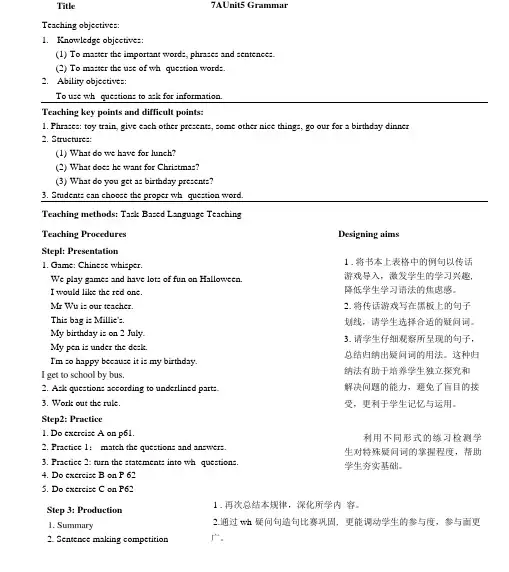
7AUnit5 GrammarTeaching objectives:1.Knowledge objectives:(1)To master the important words, phrases and sentences.(2)To master the use of wh- question words.2.Ability objectives:To use wh- questions to ask for information.Teaching key points and difficult points:1.Phrases: toy train, give each other presents, some other nice things, go our for a birthday dinner2.Structures:(1)What do we have for lunch?(2)What does he want for Christmas?(3)What do you get as birthday presents?3.Students can choose the proper wh- question word.Teaching methods: Task-Based Language TeachingTeaching Procedures Designing aimsStepl: Presentation1.Game: Chinese whisper.We play games and have lots of fun on Halloween.I would like the red one.Mr Wu is our teacher.This bag is Millie's.My birthday is on 2 July.My pen is under the desk.I'm so happy because it is my birthday.2.Ask questions according to underlined parts.3.Work out the rule.Step2: Practice1.Do exercise A on p61.2.Practice 1: match the questions and answers.3.Practice 2: turn the statements into wh- questions.4.Do exercise B on P 625.Do exercise C on P621 .再次总结本规律,深化所学内容。
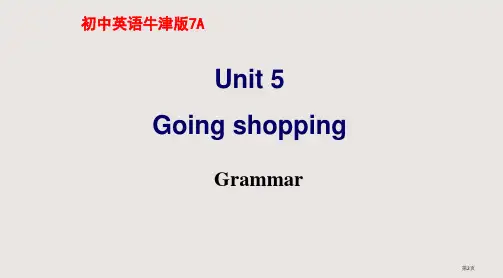
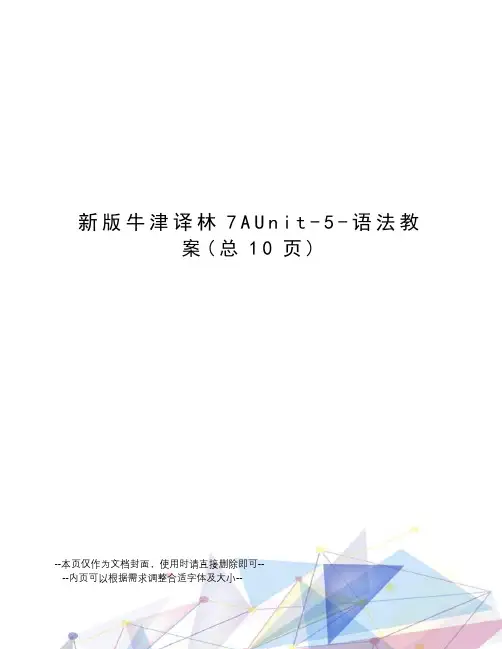
新版牛津译林7A U n i t-5-语法教案(总10页)--本页仅作为文档封面,使用时请直接删除即可----内页可以根据需求调整合适字体及大小--授课教学案学生姓名:授课教师:班主任:科目:英语上课时间: 2014 年月日时—时学生作业学生姓名:授课教师:班主任:科目:上课时间年月日时—16、—__________ do you go to the library?—Twice a week.A .How soon B. How much often D. How far17、--- is it from the bookshop to the hospital?--- It’s about twenty minutes’ walk.A. How lon gB. How farC. Howoften D. How soon18、--- does your mother go to work?--- By car.A. WhatB. WhenC.Why D. How19、—John, ______ do you visit your grandparents?—Once a week.A. how longB. how soonC. how oftenD. how much20、—_______ do you like dolphins so much—Because they’re really cute!A. WhyB. WhoC. When21、--- _______ will you come back?--- In an hour.A. How soonB. How oftenC. How farD. How long22、-- Tony, ________ are you in such a hurry?-- The meeting will start soon. I don't want to be late.A. whereB. howC.when D. why23、-- ________ can you finish this English examination-- In about one and a half hours.A. How farB. How oftenC. Howsoon D. How long24、—________will you water the plants?—In two hours.A.How long B.How soon C.How often D.How much25、- ______ do you read English newspapers?- I read China Daily every day.A. How longB. How soonC. Howoften D. How far26、--- ________ does your family go on a picnic?。
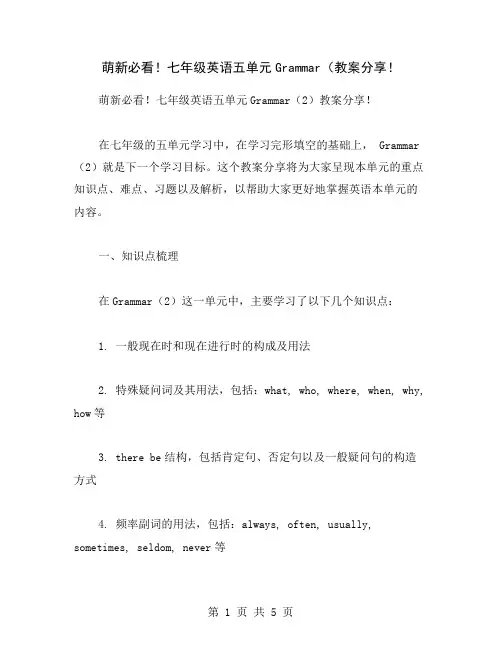
萌新必看!七年级英语五单元Grammar(教案分享!萌新必看!七年级英语五单元Grammar(2)教案分享!在七年级的五单元学习中,在学习完形填空的基础上, Grammar (2)就是下一个学习目标。
这个教案分享将为大家呈现本单元的重点知识点、难点、习题以及解析,以帮助大家更好地掌握英语本单元的内容。
一、知识点梳理在Grammar(2)这一单元中,主要学习了以下几个知识点:1. 一般现在时和现在进行时的构成及用法2. 特殊疑问词及其用法,包括:what, who, where, when, why, how等3. there be结构,包括肯定句、否定句以及一般疑问句的构造方式4. 频率副词的用法,包括:always, often, usually, sometimes, seldom, never等5. 数量词和不可数名词的使用二、难点分析1. 一般现在时和现在进行时的用法区别一般现在时表示经常性、习惯性或客观事实,而现在进行时则表示正在进行的动作。
区别在于,一般现在时的动词形式为原形,加s 或es,而现在进行时则是“be动词+现在分词”。
另外,一般现在时还可以表示现时、未来等。
2. there be结构there be结构表示“存在”。
肯定句结构是there is/are+名词,否定句则是there isn't/aren't+名词,疑问句是Is/Are there + 名词+...?的形式。
3. 频率副词的位置和用法频率副词通常放在动词前面,但是放在助动词、情态动词后面。
它们用来表示动作发生的频率,表示从总的情况看,这个动作发生的次数是多少。
四、习题练习1. 选择填空1. --______ is your schoolbag? –It’s red.A. WhatB. HowC. What colorD. Which color2. It’s important______ English well.A. learnB. to learnC. learningD. learned3. There isn´t______ sugar in the coffee.A. noB. anyC. someD. every4. They often______ sports in their free time.A. playingB. playsC. playD. played5. --______ are you going to Australia? –Next month.A. WhatB. WhereC. WhenD. Why2. 改错1. She always go to school by bike.2. How many apples do you have? –None.3. There are some books on the table.4. Do you like playing basketball or play soccer?5. Are you doing your homework in your room or in library?3. 完成句子1. I ______ ______ (通常做某事) my homework at 9:00 inthe evening.2. --______ ______ (你家附近) a park? –Yes, there is.3. I believe that you can ______ ______ (取得好成绩) inthe exam.4. --______ ______ (你多长时间) do exercise every day? –An hour.5. He is ______ ______ (在做作业) in the classroom now.四、知识点分析1. 一般现在时和现在进行时一般现在时表示客观事实,习惯或经常性动作,有时表示近期将来的动作,在句子中常常伴随着时间状语。
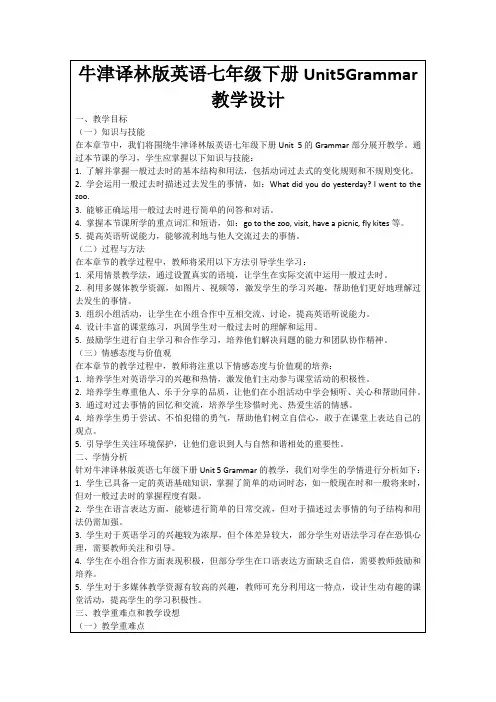
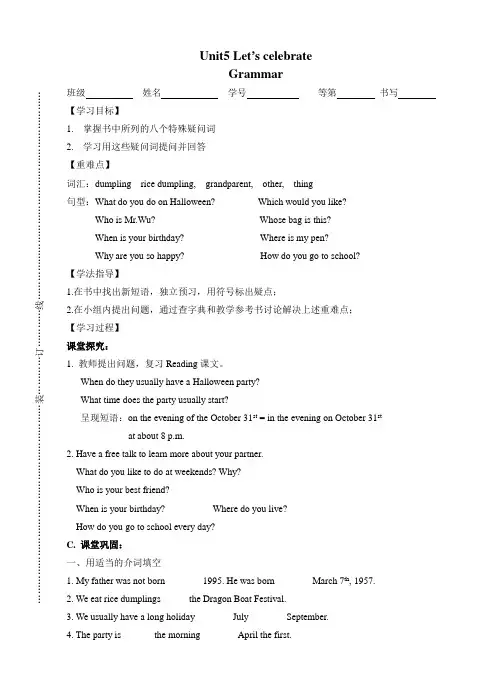
Unit5 Let ’s celebrateGrammar班级 姓名 学号 等第 书写________ 【学习目标】 1. 掌握书中所列的八个特殊疑问词 2. 学习用这些疑问词提问并回答 【重难点】 词汇:dumpling rice dumpling, grandparent, other, thing 句型:What do you do on Halloween? Which would you like? Who is Mr.Wu? Whose bag is this? When is your birthday? Where is my pen? Why are you so happy? How do you go to school? 【学法指导】 1.在书中找出新短语,独立预习,用符号标出疑点; 2.在小组内提出问题,通过查字典和教学参考书讨论解决上述重难点; 【学习过程】 课堂探究: 1. 教师提出问题,复习Reading 课文。
When do they usually have a Halloween party? What time does the party usually start? 呈现短语:on the evening of the October 31st = in the evening on October 31st at about 8 p.m. 2. Have a free talk to learn more about your partner. What do you like to do at weekends? Why? Who is your best friend? When is your birthday? Where do you live? How do you go to school every day? C. 课堂巩固: 一、用适当的介词填空 1. My father was not born _______ 1995. He was born _______ March 7th , 1957. 2. We eat rice dumplings _____ the Dragon Boat Festival.3. We usually have a long holiday _______ July _______ September.4. The party is ______ the morning _______ April the first.………………………………………………………装…………订…………线…………………………………………………………5. I like going walking _______ warm evenings.二、用特殊疑问词填空1. ____________ beautiful dresses are those? They’re Lucy and Lily’s.2. ____________ will you go to Shanghai tomorrow? By air.3. ____________ is that boy on that motorbike?He is my brother.4. ____________ don’t you go to school by bike?Becaus e my bike is broken.5. ____________ one do you like, the red one or the white one?D. 课后拓展一、短语翻译1.在端午节吃粽子__________________________________2.举行聚会来庆祝国庆节__________________________________3.有一个周一到周五的长假__________________________________4.做完作业后去看医生__________________________________5.二月在海南度假__________________________________6.喜欢在冬天跑步__________________________________7.在大厅里开俱乐部会议__________________________________8.一天中的一部分__________________________________9.喜欢带Eddie散步__________________________________10.告诉我如何庆祝儿童节__________________________________二、用适当的介词填空11.Children in China go to school ________ seven.12.The parents’ meeting starts ________ 6 _______ 7.13.Don’t talk with each other ____________ supper.14.I usually go shopping ___________ Sunday afternoon.15.We will go on a trip ___________ a cool morning ________ autumn.16.His birthday is __________ July.17.Where are you going __________ your holiday?18.I will meet him _________ the morning ________ October 2nd.19.I like listening _________ music _______ the radio.20.The teacher ________ glasses teaches us English.三、单项选择1. ---How far is your school from here?---Not very far. It’s about twenty________ walk.A. minute’sB. minutesC. minutes’D. minute2. How often do you go to the reading club?A. an hourB. twice a weekC. for a weekD. a week3. I think I can do________ than you.A. goodB. betterC. bestD. well4. Fish can’t live water.A. withB. withoutC. inD. out5. Dad, my trousers are old. I want to buy a new ___________.A. trousersB. oneC. itD. pair6. My mother will buy a new bike _______me _______ a birthday present.A. to , forB. for, toC. for, asD. to , as7. Look! There’s _________ sheep on the hill. How lovely!A. a littleB. someC. manyD. much8. The computer games center is small and there are ________ people there.A. too muchB. many tooC. too manyD. much9. He needn’t _________ about his E nglish. Miss Wang will help you.A. to worry too muchB. worry too muchC. worries much tooD. to worry much too10. It __________ hard outside, let’s not go shopping.A. rainsB. will rainingC. rainingD. is raining四、改错1. Which city does he live ?2. Who make the posters for the school display?3. The students celebrate his birthday by have a party for him.4. Granny’s birthday is in 2nd May.5. There is going to have a foreign film at the cinema this week.五、完形填空These days, computer games are becoming more and more popular in many cities and towns. A lot of small shops along busy ___69__ have changed into (变成)__70___ game houses in order to (为了)get more money. These places are always crowded with (挤满了)_71___ especially (尤其是)young boys.In the computer game houses, people __72___ a lot of money playing games on machines. It’s ___73__ for one to win a computer game, but one can make progress (进步)after __74___ againand again. People have a kind of gambling psychology (赌博心理)when they play computer games. The more they __75___, the more they want to win. For school boys, they don’t care ___76__ their lessons. When class is over, they run to the nearby computer game house. Some of them can get enough money from their parents. But some of them are not __77___ enough to get the money. They begin to take other students’ money and __78___ thieves (小偷).69. A. rivers B. cities C. villages D. streets70. A. small B. big C. computer D. sports71. A. people B. person C. women D. girls72. A. take B. win C. use D. spend73. A. easy B. hard C. important D. beautiful74. A. drive B. to make C. trying D. ran75. A. hope B. lose C. do D. make76. A. about B. at C. in D. of77. A. bad B. angry C. difficult D. lucky78. A. are B. look like C. become D. like六、缺词填空No one k_______ how man learns to make words(单词). Maybe he begins by m_________ sounds(声音) . As(随着)time goes by(流逝), he makes more and more s________ and more and more words . This is w_______ we call language .(语言)People in d________ countries make different kinds of words . Today there are about fifteen hundred(100) d______ languages in the world .About almost the anima ls can’t s____ _ , but they also have their languages . W___ a bee (蜜蜂)finds some food , it wants to tell o_________ bees where the food is , they also have their languages . It does a little dance in the air . I_____ this way it tells the other bees w_______ the food is .1. ___________2. ___________3. ___________4. ___________5. ___________6. ___________7. ___________8. ___________9. ___________ 10. ___________。
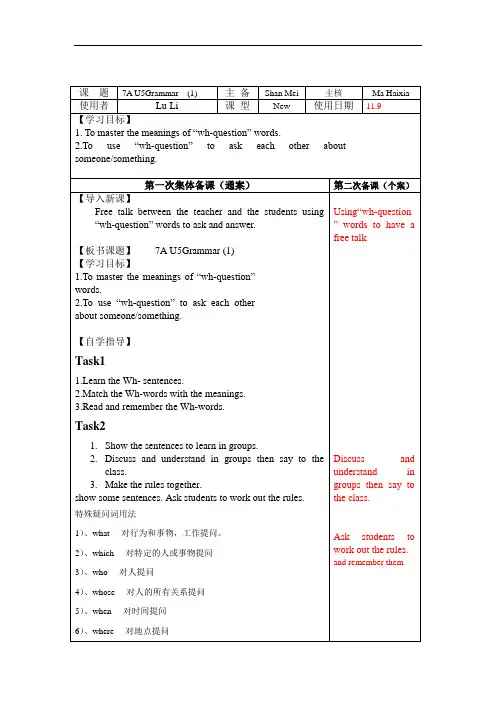
课题7A U5Grammar (1) 主备Shan Mei 主核Ma Haixia 使用者Lu Li 课型New 使用日期11.9【学习目标】1. To master the meanings of “wh-question” words.2.To use “wh-question” to ask each other aboutsomeone/something.第一次集体备课(通案)第二次备课(个案)【导入新课】Free talk between the teacher and the students using “wh-question” words to ask and answer.【板书课题】7A U5Grammar (1)【学习目标】1.To master the meanings of “wh-question”words.2.To use “wh-question” to ask each otherabout someone/something.【自学指导】Task11.Learn the Wh- sentences.2.Match the Wh-words with the meanings.3.Read and remember the Wh-words.Task21.Show the sentences to learn in groups.2.Discuss and understand in groups then say to theclass.3.Make the rules together.show some sentences. Ask students to work out the rules.特殊疑问词用法1)、what----对行为和事物,工作提问。
2)、which----对特定的人或事物提问3)、who----对人提问4)、whose----对人的所有关系提问5)、when----对时间提问6)、where----对地点提问Using“wh-question ” words to have a free talkDiscuss and understand in groups then say to the class.Ask students to work out the rules. and remember them7)、why-----对原因提问8)、how ——提问交通方式和形容词9)、how old ——提问年龄10)、how often,——提问频率11)、how many——提问可数名词数量12)、how much ——提问不可数名词数量、价格13)、what colour——提问颜色14)、what time——提问时间点15)、what class ——提问班级16)、what…do…提问干什么事17)、how long——提问时间长短for+18)、how soon-----提问时间长短in+19)、how far-----提问距离Task 31Watch the pictures and fill in the blanks with“wh-words”. (Part A)2. Get the Ss to make some dialogues according to thepictures.3. Ss practice making a dialogue like the above inpairs using more “wh-words”.4. Get some pairs to act it out before class.5. Complete some exercises.【堂清知识】1)、what----对行为和事物,工作提问。
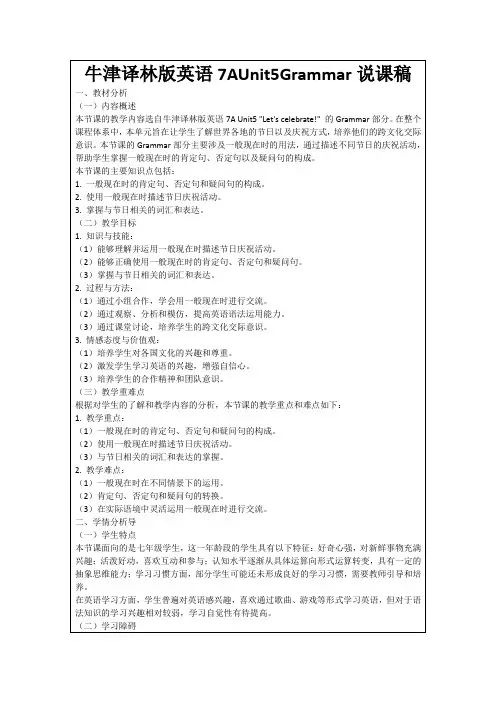
沪外教版初中英语7A-Unit-5-Grammar-现在进⾏时教学设计沪外教版初中英语7A Unit 5 After Class Getting started 第⼀课时教学设计Teaching goals:● To make students know what Present Continuous Tenseis.● To learn how to ask and answer questions using the Present Continuous Tense.Key points:Present Continuous Tense : be + doingDifficult points:●现在进⾏时的⽤法和动词的ing形式的构成●现在进⾏时各句式之间的转换。
Teaching methods:●通过图⽚设置情景教授句型。
●以听说为主,反复练习。
Teaching aids:MultimediaTeaching procedures:Step 1: Lead inⅠ⼏位同学表演⼩品请⼏位同学到讲台前,⼀个接⼀个⼀边做相应的活动,⽼师⼀边和同学们说出相应重点词汇如:sing,jump ,run,read,etc.ⅡAsk the students:“Wh at is xxx doing?”Then show s the sentences: He is listening to music.he is singing ,etc On the blackboardStep 2: PresentationⅠAsk students:“What are you doing now?”Help the students answer the question: We are having a lesson now. Then write it on the blackboard.Ⅱ Present the Present Continuous Tense: We use this tense to talk about things that are happening now. Tell students that we often use the following words with the Present Continuous Tense: now ,right now, at present, at the moment, etc.Ⅲ Show the pictures on the screen, ask questions like : what …… doing? Let the student answer the questions and write the answers on the blackboard.iT: What are you doing?S1: I’m doing my homework..ⅱT: What is Mr. Jang doing?S2: He is reading newspaper.ⅲ T: What is Eddie doing?S3: It is sleeping.ⅳ T: What are you doing?S4: We are doing eye exercises.ⅴ T: What are they doing?S5: They are running.Ⅳ Explain to the students we should use be+doing to talk about thing are happening now.Ⅴ Teach the students how to form the ing form of a verb.ⅰ⼀般情况,在动词的词尾+ing,如:do - doing, read - reading, sleep - sleeping, eat - eatingⅱ以不发⾳的e结尾的动词,去e +ing,如:dance - dancing, write-writing, make –making, have - havingⅲ以重读闭⾳节结尾的动词,末尾是⼀个辅⾳字母,前⾯是单个元⾳字母时,要双写词尾的辅⾳字母,在加ing, 如:run - running, stop – stoppingⅳ以ie结尾的单词把ie变成y再加ing,如:lie - lying Step 3: PractiseⅰShow some pictures on the screen, students then ask and answer in pairs:S1: What is Amy doing?S2: She is swimming.S3: What is Simon doing?S4: He is playing football.S5: What are the students doing?S6: They are doing morning exercises.ⅱ Divide the whole class into two groups, one group ask ,the other group answer, then exchange.Step 4: PresentingAsk students, What lesson are you having?Students answer, We are having an English Lesson.Teacher says, We are having an English Lesson. We are not having a Computer lesson.Show a picture to students, ask, “Are they having a lesson too? What are they doing?”Help the students answer, “They are having a party. They are not having a lesson.”Step5 practiseLearen to master negative sentences.S1: Kitty is dancing. Kitty is not singing.S2: The cat is eating. It is not sleeping.S3: They are making a pumpkin lantern.They are not dressing up. Then practice together.Step 6: PresentingTeacher ask, “Are you having an English Lesson?”S1: “ Yes, we are.”Teacher ask, “ Are you having a Computer Lesson?”S2: “ No, we aren’t.”Show the sentences on the screen. Have the pattern drills according to the pictures on P46 ONE.Step 7: Practising orallyS1: Is Kitty singing?S2: No, she isn’t.S1: Is Kitty dancing?S2: Yes, she is.S3: Are they chatting with each other?S4: No, they aren’t.S3: Are they playing a game?S4: Yes, they are.S5: Are we doing morning exercises?S6: No, we aren’t.S5: Are we doing eye exercises?S6: Yes, we are.Step 8 : listen and practice (p 46 2 and 3)First listen, Then ask the students to practice the dialogues in pairs.Step 9: Playing a gameShow some pictures to students, we can only see the person in the pictures, the other part of the picture is vague. Ask the students try to guess what is the person doing in each picture, they may ask like this, “Is he …?”The students who can guess correctly will get a present.Step 10: have a test (ppt.pattern transformation)Step 11: HomeworkRevise Present Continuous Tense.Do some exercises (exercise book section a)设计思路:本节的教学内容为语法——现在进⾏时。
七年级英语牛津版7AUnit5教案2 七年级英语教案Teaching Aims:1. To increase awareness of different registers2. To describe the need of oneself .3. To identify specific information about shopping from reading the conversations .Teaching Contents:1.Words: A.minute, cost , expensive ,shopkeeper ,quite ,high ,match ,pretty, mind ,somethingB .discount ,cut ,unusual2.Phrases :A.just a moment , over there , never mind , look for ,football cards ,take a look B.go well in ,as much as3.Sentence structures:A. Can I help you? What are you looking for ?How much does the cards cost ?How much are they ?I don 't have enough money to buy her a CD then .I 'll buy them .B.That 's quite expensive .There 's a discount on last year 's cards .They match her favourite T_shirt !Teaching procedures:StepⅠ Presentation.Many girls in this class have hair clips . Their hair clips are very pretty . They match their clothes well. Are they beautiful ?Do you mind showing your clips to me ?Wow .They are beautiful clips . How much do they cost ?10yuan .?They are quite expensive .Oh ,Just a moment , Where is my book ?Please help me find my book ,Mmm. Never mimd . Oh ,Someone says it 's over there .Yeah , That 's right .Thank you .Learn the new words and phrases :pretty ,match , cost ,expensive .just a moment , over there , never mindStepⅡPracticeDo Part B 1.Fill in the blanks with the corret phrases :just a moment , over there , never mind , look for ,take a look。
牛津初中英语7A Unit 5 Grammar 现在进行时教学设计2007-08-2810:14分类:教学设计字号:大中小本教学设计获芜湖市2007中小学教学设计三等奖Teaching goals:● To make students know what Present Continuous Tenseis.● To learn how to ask and answer questions using thePresent Continuous Tense.Key points:Present Continuous Tense : be + doingDifficult points:●现在进行时的用法和动词的ing形式的构成●现在进行时各句式之间的转换。
Teaching methods:●通过图片设置情景教授句型。
●以听说为主,反复练习。
Teaching aids:MultimediaTeaching procedures:Step 1: Lead inⅠ三位同学表演小品同学Tom一边听mp3一边走,突然钱包掉了,但并不知道。
同学Mike和Paul走上前去,Mike拾起钱包说:“It must be Tom’s.”并朝着Tom高声喊到:“Tom,your wallet!Tom,your wallet!”可Tom却并不理会,这时Paul指着Tom说:“Look,he is listeningto musi c.”ⅡAsk the students:“Why can’t Tom hear Mike?”Then show the sentence: He is listening to music.” On the screenStep 2: PresentationⅠAsk students:“What are you doing now?”Help the students answer the question: We are having a lesson now. Then write iton the blackboard.Ⅱ Present the Present Continuous Tense: We use this tense to talk about things that are happening now. Tell students that we often use the following words with the Present Continuous Tense: now ,right now, at present, at the moment, etc.Ⅲ Show the pictures on the screen, ask questions like : what …… doing? Let the student answer the questions and write the answers on the blackboard.ⅰT: What are you doing?S1: I’m doing my homework..ⅱT: What is Mr. Jang doing?S2: He is reading newspaper.ⅲ T: What is Eddie doing?S3: It is sleeping.ⅳ T: What are you doing?S4: We are doing eye exercises.ⅴ T: What are they doing?S5: They are running.Ⅳ Explain to the students we should use be+doing to talk about thing are happening now.Ⅴ Teach the students how to form the ing form of a verb.ⅰ一般情况,在动词的词尾+ing,如:do - doing, read - reading, sleep - sleeping, eat -eatingⅱ以不发音的e结尾的动词,去e +ing,如:dance - dancing, write-writing, make –making, have - havingⅲ以重读闭音节结尾的动词,末尾是一个辅音字母,前面是单个元音字母时,要双写词尾的辅音字母,在加ing, 如:run - running, stop – stoppingⅳ以ie结尾的单词把ie变成y再加ing,如:lie - lyingStep 3: PractiseⅰShow some pictures on the screen, students then ask andanswer in pairs:S1: What is Amy doing?S2: She is swimming.S3: What is Simon doing?S4: He is playing football.S5: What are the students doing?S6: They are doing morning exercises.ⅱ Divide the whole class into two groups, one group ask ,the other group answer, then exchange.Step 4: PresentingAsk students, What lesson are you having?Students answer, We are having an English Lesson. Teacher says, We are having an English Lesson. We are not having a Computer lesson.Show a picture to students, ask, “Are they having a lesson too? What are they doing?”Help the students answer, “T hey are having a party. They are not having a lesson.”Step 5: Practice the positive and negative forms orally according to the picturesS1: Kitty is dancing. Kitty is not singing.S2: The cat is eating. It is not sleeping.S3: They are making a pumpkin lantern. They are not dressingup.Then practice together.Step 6: Doing Part A on page 80Step 7: PresentingTeacher ask, “Are you having an English Lesson?”S1: “ Yes, we are.”Teacher ask, “ Are you having a Computer Lesson?”S2: “ No, we aren’t.”Show the sentences on the screen.Step 8: Practising orallyS1: Is Kitty singing?S2: No, she isn’t.S1: Is Kitty dancing?S2: Yes, she is.S3: Are they chatting with each other?S4: No, they aren’t.S3: Are they playing a game?S4: Yes, they are.S5: Are we doing morning exercises?S6: No, we aren’t.S5: Are we doing eye exercises?S6: Yes, we are.Then students practice together.Step 9: Playing a gameShow some pictures to students, we can only see the person in the pictures, the other part of the picture is vague. Ask the students try to guess what is the person doing in eachpicture, they may ask like this, “Is he …?”The students who can guess correctly will get a present.Step 10: Do Part B on Page 81Step 11: HomeworkRevise Present Continuous Tense.Do some exercises.设计思路:本节的教学内容为语法——现在进行时。
总的来说,在所有的时态中,现在进行时是较容易掌握的,加之学生们在小学就有所接触,因此本节课内容安排稍多,要求学生初步掌握现在进行时的基本构成——be + doing 以及现在进行时的各种句式即肯定句,否定句,一般疑问句及回答。
⒈由学生表演的小品导入,使学生们从中领悟在什么情况下要用到现在进行时。
⒉通过出示大量的图片使教学更加直观,且大部分图片都是学生们日常校园生活的真实照片,这让学生们产生亲近感并可以有效激发兴趣,同时也使得话题谈论更加真实贴近生活实际,各个人称都能自然兼顾,因此也就更容易被学生掌握。
⒊精心选择动作和活动的词语,包括饮食,学习,教学,体育,娱乐和生活起居等。
⒋在句式的转换上,通过具体而典型的情景引导学生自己从中领悟出其用法并总结其构成。
⒌任何语言形式只有通过实践才能加深理解。
因此在学生归纳出语言形式和规则后,组织学生围绕图片进行会话操练,整节课努力实践现代语法课所提倡的“精讲多练,以练代教,点到为止,注重运用,灵活新颖”的教学方式,提供给学生更多的领悟空间。
⒍最后设计了一个猜图游戏。
给学生一组照片,但只能看到图中的人物,其它部分则做了模糊处理,让学生猜测图中人物正在做什么。
从而在游戏中巩固了时态用法。
参考文献:《英语课程标准》《新课程教学问题解决实践研究(初中英语)》,中央民族大学出版社2006年2月第一版。